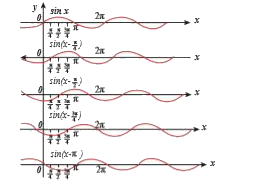How does the wave y=sin(x-a) for a = 0 , a=π4,a=π2,a=3π2 and a=π look like? Sketch this wave.
Text Solution

From the above picture we observe that
y=sin(x-a) for a = 0, a=π4,a=π2,a=3π2 and a=π, the function y=sin(x-a) shifts towards right. Further, we can take a=vt and v=π4, and sketching for different times t = 0 s , t = 1 s, t = 2 s etc., we once again observe that y = sin(x-vt) moves towards the right. Hence, y=sin(x-vt) is a travelling (or progressive) wave moving towards the right. If y= sin(x+vt) then the travelling (or progressive) wave moves towards the left. Thus, any arbitrary function of type y = f(x-vt) characterising the wave must move towards right and similarly, any arbitrary function of type y = f(x+vt) characterizing the wave must move towards left.
|
Topper's Solved these Questions
- WAVESBOOK - NCERT TAMILCHAPTER - WAVESEXERCISE - EVALUATION(I. MULTIPLE CHOICE QUESTIONS)
15 Videos
- WAVESBOOK - NCERT TAMILCHAPTER - WAVESEXERCISE - EVALUATION(IV. NUMERICAL PROBLEMS)
7 Videos
- WAVESBOOK - NCERT TAMILCHAPTER - WAVESEXERCISE - EVALUATION(IV. NUMERICAL PROBLEMS)
7 Videos
- UNITS AND MEASUREMENTBOOK - NCERT TAMILCHAPTER - UNITS AND MEASUREMENTEXERCISE - EXERCISE (ADDITIONAL EXERCISE)
9 Videos
- WORK, ENERGY AND POWERBOOK - NCERT TAMILCHAPTER - WORK, ENERGY AND POWEREXERCISE - EXERCISE - IV. NUMERICAL PROBLEMS
5 Videos
Similar Questions
Knowledge Check
A transverse wave is described by the equatiion Y=Y0sin2π(ft−x/λ). The maximum particle velocity is equal to four times the wave velocity if
λ=πY0/4
λ=πY0/2
λ=πY0
λ=2πY0Aλ=πY0/4Bλ=πY0/2Cλ=πY0Dλ=2πY0The equation of a progressive wave is y=4sin(4πt−0.04x+π3) where x is in metre and t is in second. The velocity of the wave is
A100πms−1B50πms−1C25πms−1Dπms−1A transverse wave propagating along x-axis is represented by: y(x,t)=8.0sin(0.5πx−4πt−π4) Where x is in metres and t is in seconds. The speed of the wave is:
A4πm/sB0.5πm/sCπ4m/sD8m/s
Sketch the graph : y=2sin(x−π4)
View SolutionOn the superposition of two waves [y1=3sin(50πt−20x)] and [y2=3sin(50πt−20x+(π3)]the equation resultant wave will be
View SolutionOn the superposition of two waves [y1=3sin(50πt−20x)] and [y2=3sin(50πt−20x+(π3)]the equation resultant wave will be
View SolutionThe possible values of θ∈(0,π) such that sin(θ)+sin(4θ)+sin(7θ)=0 are (1) 2π9,i4,4π9,π2,3π4,8π9 (2) π4,5π12,π2,2π3,3π4,8π9 (3) 2π9,π4,π2,2π3,3π4,35π36 (4) 2π9,π4,π2,2π3,3π4,8π9
View SolutionThe possible values of θ∈(0,π) such that sin(θ)+sin(4θ)+sin(7θ)=0 are (1) 2π9,i4,4π9,π2,3π4,8π9 (2) π4,5π12,π2,2π3,3π4,8π9 (3) 2π9,π4,π2,2π3,3π4,35π36 (4) 2π9,π4,π2,2π3,3π4,8π9
View Solution
